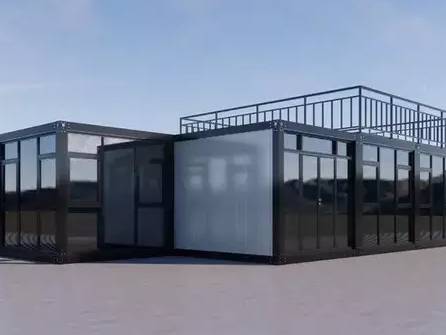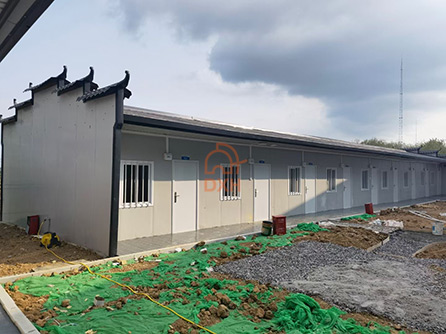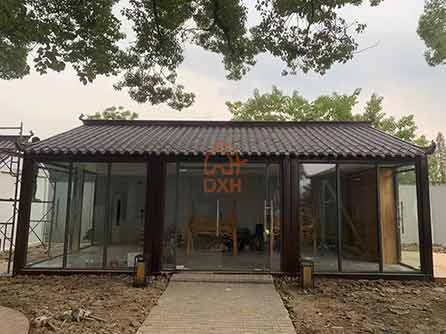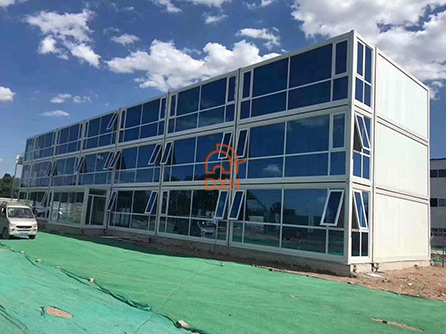Jan 16, 2025
1. The highlights and advantages of the product
(1). Solid and reliable structure
The main frame is made of high-strength hot-dip galvanized steel, with a galvanized layer thickness of 110μm, which has been tested by SGS for 100 hours of salt spray, which has excellent anti-rust ability, and is suitable for all kinds of environments, ensuring the long-term stability of the house structure and ensuring the safety of living and use.
The structural connection is fixed by screws to make the overall frame tight and firm, and the wind resistance is greater than 110km/h and the seismic resistance level is greater than 11 after professional testing, providing customers with a safe and reliable living space.
(2). Efficient and convenient features
The construction period is shorter than that of traditional houses, and the standard size detachable container house only takes about 6 hours to complete the whole process from transportation to put into use, which greatly saves time and cost compared with traditional houses, and can meet the needs of temporary activity venues, emergency resettlement and other scenarios that require high building stability in terms of timeliness.
Bulk delivery, can make full use of the internal space of the sea container to reduce transportation costs, can achieve global distribution through a variety of transportation methods, and can be flexibly moved many times, easily meet the requirements of different site layout.
(3). Excellent environmental adaptability
The wall adopts 50mm EPS/Rockwool sandwich panel as the standard configuration, which can be customized with 75mm, 100mm and other thicknesses, and the thermal conductivity is as low as 0.022W/(m·K), which effectively blocks heat transfer, maintains stable indoor temperature, reduces energy consumption, and achieves good thermal insulation effect. For colder regions, customization options such as graphene electric flooring are available.
The roof is made of 0.45mm hot-dip galvanized color coated roll, combined with glass wool and 0.25mm internal ceiling hot-dip galvanized color coated roll, which has good thermal insulation performance and strength, can resist the influence of natural factors such as rain erosion and ultraviolet erosion, and can also add additional roof to enhance the effect of heat insulation and waterproofing and relieve the pressure of heavy snow, while improving the aesthetics.
The windows are made of double-layer insulating glass, which effectively increases the thermal insulation and sound insulation effect, reduces heat loss, and creates a comfortable indoor environment.
(4). Ultra-long service life
The overall design service life of the house is greater than 30 years, and high-quality steel and advanced manufacturing technology are used to ensure that the house can have better stability in long-term use, reduce the cost of repair and maintenance, and provide customers with safe and lasting living and use space, whether it is as a permanent residence, commercial office space or other application scenarios, it can meet the needs for a long time.
2. Details of the main frame structure
Medium Container:
Top and bottom vertical beam:15X15X2.3mm Q235B and 15X15X2.3mm Q235B
Top and bottom corssbeam:2.3mm special shaped beam Q235B
Top Purlin:40X60X1.0mm Q235B + 40X80X1.0mm Q235B+50X50X1.5mm Q235B
Bottom Purlin:40X80X1.0mm Q235B+80X80X1.0mm Q235B
3. Detailed specification parameter chart
Components
Specification Details
Performance Benefits
Wall panel
EPS/Rockwool sandwich panels, thickness is commonly used 50mm (customizable 75/100mm)
The thermal conductivity is 0.022W/(m·K), and the thermal insulation performance is excellent
Roof
0.45mm hot-dip galvanized prepainted coil
Strong weather resistance, resistant to rain and ultraviolet erosion
Ceiling
Glass wool + 0.25mm hot-dip galvanized color-coated roll internal ceiling
The thermal insulation effect is good, and the double slope roof can be selected to enhance the performance and aesthetics
Floor
15mm glass magnesium flooring
Provides solid support and ensures stability on the ground
Windows
Double-walled insulating glass
The hollow layer improves the thermal insulation and sound insulation effect and reduces heat loss
Size
Standard size W3000*L5950*H2800mm, support customized other sizes
Flexible customization according to customer needs to meet diverse space needs
4. the standard detachable container house size chart
Size
External dimensions after installation (mm)
Internal dimensions after installation (mm)
Weight (kg)
Loading quantity
20ft
W3000*L5950*H2800
W2800*L5735*H2500
1200
40HQ 17units
5. Customized services
The company is able to meet the customized needs of customers and provide a full range of customized services. In addition to the standard size, a variety of sizes can be customized according to the actual site and use plan to accurately meet various needs. In terms of materials, in addition to the optional wall thickness, free material color customization is also provided, covering wall panels, frames, doors and windows, flooring, etc., to ensure that the house is perfectly integrated with the environment and the project theme. Electrical systems, toilets and other internal facilities can be customized on demand to adapt to different national and regional standards; We also provide OEM, ODM services, packaging can be OEM, our company has rich experience and professional team, with strong customization capabilities, can create a unique detachable container house, widely used in tourism, commercial office, permanent residence, education, outdoor leisure and other fields.
6. Application scenarios
(1). Temporary residence
Construction site dormitories: Construction sites have a long construction period, and workers need stable and convenient accommodation. The integrated house can be built quickly to provide a comfortable living environment for workers, with beds, tables and chairs, toilets, and shower facilities, and can also be flexibly spliced and expanded according to the number of workers, and can be disassembled and relocated to the next construction site after the project is completed.
Disaster relief settlements: After earthquakes, floods, typhoons and other natural disasters, a large number of victims are in urgent need of temporary shelter. Easy to transport and quick to install, the integrated house can set up a resettlement community in the affected area within a few days, ensuring that the victims have shelter from the wind and rain, keeping warm and cold, and helping them through the difficult transition period.
Temporary housing for large-scale events: When holding large-scale events such as the Olympic Games, World Cup, and music festivals, there are a large number of volunteers and staff, and the integrated housing can quickly build temporary dormitories around the event venue to meet the needs of large-scale personnel accommodation in the short term, and can be easily dismantled after the event. Commercial & Office Use
(2). Travel and vacation
Characteristic homestays: In tourist attractions, seashores, mountainous areas and other places, integrated house B&Bs with unique shapes and different styles are deeply loved by tourists. It can be a Scandinavian-style log cabin that blends into the forest landscape; It can also be a coastal style container homestay, with a terrace and a sea view, bringing tourists a different accommodation experience.
Vacation villas: For people who pursue personalized vacation life, integrated houses can be customized to create private holiday villas, with spacious internal space, luxurious facilities, and can also be built on the site of natural scenery such as mountains and rivers, pastorals, etc., with both privacy and comfort.
Campsite accommodation: In addition to traditional tents, campsites are becoming more popular for integrated house-style "glamping" units, which are equipped with beds, electricity, and private bathrooms, allowing campers to enjoy the convenience of modern life while being close to nature without having to work hard.
(3). Public facilities
Public toilets: urban parks, scenic spots, streets and other areas with high traffic can be quickly integrated with house-type public toilets. These toilets are designed to be environmentally friendly, with water-saving appliances, clean interiors, and exterior that blends in with the surrounding environment to improve the city's public services.
Rest Stations for Sanitation Workers: Rest Stations for Sanitation Workers in Integrated Houses on both sides of the street provide sanitation workers with shelter from the wind and rain, rest and drink water, and store tools, reflecting the city's care for front-line workers.
(4). Education
Temporary teaching sites: When schools in remote mountainous areas encounter damage to school buildings due to natural disasters, or the number of students increases suddenly, the integrated house can quickly build temporary classrooms, equip tables, chairs, blackboards, and multimedia teaching equipment to ensure the uninterrupted development of teaching activities.
Campus function expansion: In urban campuses, integrated houses are used to expand characteristic teaching areas, such as pottery classrooms, robotics laboratories, psychological counseling rooms, etc., to meet the diverse space needs of quality education at low cost and high efficiency.
(5). Healthcare
Temporary medical stations: In remote villages, communities, or during the period of epidemic prevention and control, integrated houses can quickly set up temporary medical stations, set up consultation rooms, treatment rooms, and drug storage rooms to supplement the shortcomings of primary medical resources and respond to public health emergencies.
Rehabilitation and recuperation centers: Some small rehabilitation and recuperation institutions use integrated houses and are located in the suburbs with beautiful environment to create a quiet and well-equipped rehabilitation space to assist patients in physical and mental recuperation.
7. the price advantage
Our detachable container house is significantly competitively priced, there are no hidden fees. Compared with products in the same industry, under the same quality and configuration, our price is more advantageous, so that customers can obtain high-quality space solutions at a lower cost and create greater value for customers.
8. Delivery capacity
Suzhou Daxiang container House Co., Ltd. has a strong delivery capacity, far exceeding the level of its peers. Our factory can deliver in four days at the earliest, for orders within 60 sets, we guarantee delivery in 3-4 days, and orders within 200 sets can be delivered to customers within a week. Our efficient production process and perfect supply chain management system ensure the rapid processing and timely delivery of orders, so that customers do not need to worry about construction delays, and can be quickly put into use to meet the needs of various urgent or time-sensitive projects.
9. Logistics and transportation
We offer a variety of flexible trade process options, including EXW, FOB, CIF, DDP, etc., to support sea and rail transportation methods to meet customers' different logistics needs and cost budgets. We have a dedicated logistics department and have established long-term and stable cooperative relations with many shipping companies, which can ensure the priority booking of shipping space and the safe transportation of goods. With rich logistics experience and professional team, we can quickly provide customers with accurate logistics quotations, and logistics costs are lower than industry standards, saving transportation costs for customers, providing convenient, efficient and economical logistics solutions to ensure that products are delivered to customers around the world on time and safely.
10. Warranty commitment
We provide up to 5 years quality warranty service for every customer, during the warranty period, for any failure or damage caused by product quality problems, we will repair or replace parts for customers free of charge, so that customers have no worries. Whether it is structural components, walls, roofs, doors and windows, or internal electrical systems, plumbing, etc., as long as there is a quality problem, we will quickly respond and solve it to ensure that the house is always in good condition, and protect the rights and interests of customers and the return on investment.
11. Example of installation steps
(1). Site selection and preparation: select the flat and hardened ground to place the house, ensure that the ground is level, and try to avoid placing the house in a low-lying place to prevent rainwater backlogging. If the site is in a low-lying area, it can be considered to build a concrete foundation or steel structure support foundation according to the actual situation to ensure the stability and safety of the house.
(2). Housing installation and positioning: transport the loose materials to the selected site, and arrange workers to install them in the correct steps and sequence
(3). External water and electricity connection (optional solar energy): The power supply interface and water pipe interface can be installed on site outside the house, and the external power supply and water pipe can be connected to the corresponding interface to ensure the normal water and electricity supply. If the customer chooses to use solar energy, they can install solar panels on the roof of the house or at a suitable location around the periphery according to the installation instructions of the solar equipment, and connect them to the electrical system inside the house to achieve solar power supply and improve the flexibility and environmental protection of energy use.
(4). Installation and commissioning of internal facilities: installation and commissioning are carried out according to customer-customized internal facilities, such as cabinets, etc. Make sure that the cabinet is installed firmly, the door opens and closes smoothly, and the internal storage space is reasonably laid out to meet the needs of use. Carry out a comprehensive inspection and commissioning of other internal facilities, such as electrical systems, toilet facilities (if customized), etc., to ensure that the facilities are operating normally and that the house can be delivered to customers for normal use.
Choosing detachable container house from Suzhou Daxiang Integrated Housing Co., Ltd. is choosing an innovative, efficient, environmentally friendly, comfortable and cost-effective living and working space solution. With excellent quality, professional service, rich experience and strong customization capabilities, we will carefully create the ideal residential and commercial space for you, and work together to open a new chapter of a better life and career development, and move towards a better future together.
Read More



